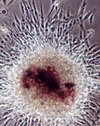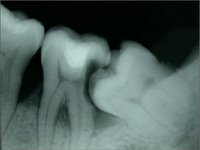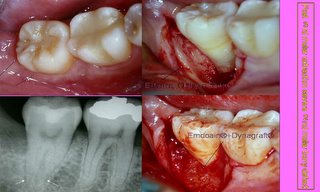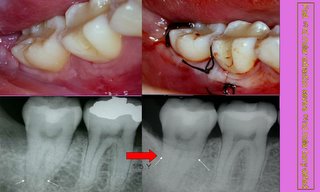Ridge alterations following implant placement in fresh extraction sockets: an experimental study in the dog
Mauricio G. Araújo1,2, Flavia Sukekava1, Jan L. Wennström2 and Jan Lindhe2J Clin Periodontol 2005; 32: 645~652
Objective: To study dimensional alterations of the alveolar ridge that occurred following implant placement in fresh extraction sockets.
Material and Methods: Five beagle dogs were included in the study. In both quadrants of the mandible, incisions were made in the crevice region of the third and fourth pre-molars. Buccal and minute lingual full-thickness flaps were elevated. The mesial root of the four pre-molars root was filled and the teeth were hemi-sected. Following flap elevation in 3P3 and 4P4 regions, the distal roots were removed. In the right jaw quadrants, implants with a sand blasted and acid etched (SLA) surface were placed in the fresh extraction sockets, while in the left jaws the corresponding sockets were left for spontaneous healing. The mesial roots were retained as surgical control teeth. After 3 months, the animals were examined clinically, sacrificed and tissue blocks containing the implant sites, the adjacent tooth sites (mesial root) and the edentulous socket sites were dissected, prepared for ground sectioning and examined in the microscope.
Results: At implant sites, the level of bone-to-implant contact (BC) was located 2.6±0.4 mm (buccal aspect) and 0.2±0.5 mm (lingual aspect) apical of the SLA level. At the edentulous sites, the mean vertical distance (V) between the marginal termination of the buccal and lingual bone walls was 2.2±0.9 mm. At the surgically treated tooth sites, the mean amount of attachment loss was 0.5±0.5 mm (buccal) and 0.2±0.3 mm (lingual).
Conclusions: Marked dimensional alterations had occurred in the edentulous ridge after 3 months of healing following the extraction of the distal root of mandibular pre-molars.
The placement of an implant in the fresh extraction site obviously failed to prevent the re-modelling that occurred in the walls of the socket. The resulting height of the buccal and lingual walls at 3 months was similar at implants and edentulous sites and
vertical bone loss was more pronounced at the buccal than at the lingual aspect of the ridge. It is suggested that the
resorption of the socket walls that occurs following tooth removal must be considered in conjunction with implant placement in fresh extraction sockets.
Dynamics of bone tissue formation in tooth extraction sites
An experimental study in dogs
G. Cardaropoli1, M. Araújo1,2 and J. Lindhe1J Clin Periodontol 2003; 30, 809~818
Objectives: The aim of the present experiment was to study events involved in the healing of marginal, central and apical compartments of an extraction socket, from the formation of a blood clot, to bone tissue formation and remodeling of the newly formed hard tissue.
Material and Methods: Nine mongrel dogs were used for the experiment. The fourth mandibular premolars were selected for study and were divided into one mesial and one distal portion. The distal root was removed and the socket with surrounding soft and mineralized tissue was denoted "experimental unit". The dogs were killed 1, 3, 7, 14, 30, 60, 90, 120 and 180 days after the root extractions. Biopsies including the experimental units were demineralized in EDTA, dehydrated in ethanol and embedded in paraffin. Serial sections 7 m thick were cut in a mesio-distal plane. From each biopsy, three sections representing the central part of the socket were selected for histological examination. Morphometric measurements were performed to determine the volume occupied by different types of tissues in the marginal, central and apical compartments of the extraction socket at different intervals.
Results: During the first 3 days of healing, a blood clot was found to occupy most of the extraction site. After seven days this clot was in part replaced with a provisional matrix (PCT). On day 14, the tissue of the socket was comprised of PM and woven bone. On day 30, mineralized bone occupied 88% of the socket volume. This tissue had decreased to 15% on day 180. The portion occupied by bone marrow(BM) in the day 60 specimens was about 75%, but had increased to 85% on day 180.
Conclusion: The healing of an extraction socket involved a series of events including the formation of a coagulum that was replaced by (i) a
provisional connective tissue matrix, (ii)
woven bone, and (iii)
lamellar bone and
BM. During the healing process a hard tissue bridge
cortical bone formed, which "closed" the socket.
Healing of extraction sockets and surgically produced augmented and non-augmented defects in the alveolar ridge. An experimental study in the dog
G. Cardaropoli
1, M. Araújo
1,2, R. Hayacibara
2, F. Sukekava
2 and J. Lindhe
1J Clin Periodontol 2005; 32: 435~440
Objectives: The current experiments had three aims (i) to determine whether the absence of the periodontal ligament (PDL) may alter features of the healing of an extraction socket, (ii) to examine if there were differences in the proportion of different tissues in resolved extraction sockets and surgically produced defects after 3 months of healing, (iii) to study the influence of different biomaterials on the healing of surgically produced bone defects.
Material and Methods: Extraction sites: In five dogs, the 4th mandibular pre-molars were hemi-sected and the distal roots were removed. The extraction socket of one of the pre-molars was instrumented to eliminate all remnants of the PDL tissue. The socket of the contra-lateral pre-molar was left without instrumentation. The dogs were sacrificed after 3 months of healing.
Defect sites: In five dogs, the pre-molars and 1st molars on both sides of the mandible were first removed and 3 months of healing allowed. After this interval three standardized cylindrical defects were prepared in each side of the mandible. The defects were 3.5 mm in diameter and 8 mm deep.
In each quadrant one defect was grafted with Bio-Oss® Collagen, one with Collagen Sponge and one defect was left non-grafted. The dogs were sacrificed 3 months after the grafting procedure.
Results: Extraction sites: The two categories of extraction sockets did not differ with respect to gross morphological features. The tissue of the extraction sites, apical of a newly formed bone bridge, was dominated by bone marrow. Few trabeculae of lamellar bone were also present.
Defect sites: The non-augmented defect was sealed by a hard-tissue bridge. In the central and apical portions of the defect bone marrow made up about 61%, and mineralized bone 39% of the tissues. The invagination of the surface of this crestal bone was 0.8±0.3 mm.
The defect augmented with Collagen Sponge was covered by a hard-tissue bridge 38% of the tissue within the defect was made up of bone marrow while the remaining 62% was occupied by mineralized bone. The invagination of the hard-tissue bridge was on the average 0.6±0.1 mm.
In defects augmented with Bio-Oss® Collagen the biomaterial occupied a substantial portion of the tissue volume. Eighty-five percent of the periphery of the Bio-Oss® particles were found to be in direct contact with newly formed mineralized bone. Woven bone and bone marrow made up 47% and 26% of the newly formed tissue. The invagination of the most coronal part of the bone defect was 0.1±0.1 mm.
Conclusion: Sockets that following tooth removal had their
PDL tissue removed exhibited similar features of healing after 3 months as sockets which had the PDL retained. The tissues present in an extraction site appeared to be more mature than those present in a surgically produced defect of similar dimension. The
Bio-Oss® Collagen augmented defect exhibited less wound shrinkage than the non-augmented defect.
Dimensional ridge alterations following tooth extraction. An experimental study in the dog
Mauricio G. Araújo1,2 and Jan Lindhe2J Clin Periodontol 2005; 32: 212~218
Objective: To study dimensional alterations of the alveolar ridge that occurred following tooth extraction as well as processes of bone modelling and remodelling associated with such change.
Material and Methods: Twelve mongrel dogs were included in the study. In both quadrants of the mandible incisions were made in the crevice region of the 3rd and 4th premolars. Minute buccal and lingual full thickness flaps were elevated. The four premolars were hemi-sected. The distal roots were removed. The extraction sites were covered with the mobilized gingival tissue. The extractions of the roots and the sacrifice of the dogs were staggered in such a manner that all dogs contributed with sockets representing 1, 2, 4 and 8 weeks of healing. The animals were sacrificed and tissue blocks containing the extraction socket were dissected, decalcified in EDTA, embedded in paraffin and cut in the buccal lingual plane. The sections were stained in haematoxyline eosine and examined in the microscope.
Results: It was demonstrated that marked dimensional alterations occurred during the first 8 weeks following the extraction of mandibular premolars. Thus, in this interval there was a marked osteoclastic activity resulting in resorption of the crestal region of both the buccal and the lingual bone wall. The reduction of the height of the walls was more pronounced at the buccal than at the lingual aspect of the extraction socket. The height reduction was accompanied by a "horizontal" bone loss that was caused by osteoclasts present in lacunae on the surface of both the buccal and the lingual bone wall.
Conclusions: The resorption of the buccal/lingual walls of the extraction site occurred in two overlapping phases. During
phase 1, the
bundle bone was resorbed and replaced with woven bone. Since the crest of the buccal bone wall was comprised solely of bundle this modelling resulted in substantial vertical reduction of the buccal crest.
Phase 2 included resorption that occurred from the outer surfaces of both bone walls. The reason for this additional bone loss is presently not understood.
Hard-tissue alterations following immediate implant placement in extraction sitesDaniele Botticelli1,2, Tord Berglundh1 and Jan Lindhe1J Clin Periodontol 2004;32:820~828
Background: The marginal gap that may occur following implant installation in an extraction socket may be resolved by hard-tissue fill during healing.
Objective: To study dimensional alterations of hard tissues that occur following tooth extraction and immediate placement of implants.
Material and methods: Eighteen subjects with a total of 21 teeth scheduled for extraction were included. Following flap elevation and the removal of a tooth and implant installation, clinical measurements were made to characterize the dimension of the surrounding bone walls, as well as the marginal defect. No membranes or filler material was used. The flaps were subsequently replaced and secured with sutures in such a way that the healing cap of the implant was exposed to the oral environment. After 4 months of healing a re-entry procedure was performed and the clinical measurements were repeated.
Results: Fifty-two marginal defects exceeding 3 mm were present at baseline: 21 at buccal, 17 at lingual/palatal, and 14 at approximal surfaces. At the re-entry eight defects exceeding 3.0 mm remained. During the 4 months of healing, the bone walls of the extraction underwent marked change. The horizontal resorption of the buccal bone dimension amounted to about 56%. The corresponding resorption of the lingual/palatal bone was 30%. The vertical bone crest resorption amounted to 0.3±0.6 mm (buccal), 0.6±1.0 mm (lingual/palatal), 0.2±0.7 mm (mesial), and 0.5±0.9 mm (distal).
Conclusion: The
marginal gap that occurred between the metal rod and the bone tissue following implant installation in an extraction socket may
predictably heal with new bone formation and defect resolution. The current results further documented that marginal gaps in buccal and palatal/lingual locations were resolved through
new bone formation from the inside of the defects and substantial bone resorption from the outside of the ridge.
Resolution of bone defects of varying dimension and configuration in the marginal portion of the peri-implant bone
An experimental study in the dogDaniele Botticelli, Tord Berglundh and Jan LindheJ Clin Periodontol 2004; 31: 309~317
Background: It was demonstrated that a marginal defect of about 1 mm between the bone wall and the metal surface after implant installation can heal with a high degree of bone fill and osseointegration.
Objective: The aim of the present animal experiment was to study bone healing at implant sites with hard tissue defects of varying dimensions and configuration.
Material and Methods: Four Labrador dogs were used. All mandibular premolars and first molars were extracted. After 3 months of healing, five experimental sites, two control (C1, C2) and three test (T1, T2, T3) sites, were identified. In all five sites, custom-made implants with a sand-blasted, large-grit, acid-etched (SLA) surface and with an outer dimension of 3.3 10 mm, were used. In site C1, traditional implant installation was performed. In site C2, the marginal 5 mm of the canal, prepared for the implant, was widened to 5.3 mm using a step-drill. Thus, following the installation of the implant, a circumferential gap occurred between the bone tissue and the metal rod that was 5 mm deep and between 1 and 1.25 mm wide. In test site T1, the canal was widened to establish a marginal gap of 2 2.25 mm. In test sites T2 and T3, the marginal 5 mm of the canal was first widened to 5.3 mm (T2) or 7.3 mm (T3). The buccal bone wall opposite the defect was subsequently removed. Following the placement of a cover screw in sites C2, T1, T2, and T3, a resorbable membrane was placed over the defect. All implants were submerged. After 4 months of healing, block biopsies of each implant site were dissected and processed for ground sectioning.
Results: The observations disclosed that four-wall defects of different dimensions (1 2.25 mm wide) that occurred in the marginal portion of the recipient sites following implant installation were resolved during healing. Further, at sites where the buccal bone wall during defect preparation was intentionally removed, healing resulted in defect resolution at the mesial, distal, and lingual aspects. At the buccal aspects, healing was incomplete but the dimension of the defect was reduced by the limited amounts of new bone formation extending from the lateral and apical borders of the defect.
Conclusion:
Wide marginal defects may during healing be filled with bone. In such defects a high degree of osseointegration may occur to implants designed with an
SLA surface.




